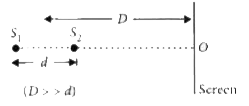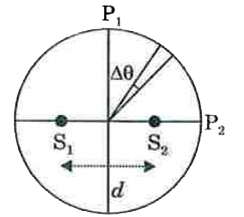Two points nonochromatic and coherent sources of light of wavelength λ each are placed as shown in figure. The initial phase difference between the sources is zero O. (d>>d). Mark the correct statement(s).

If d=7λ2, the point 'O' will be minima.
If d=λ , only one maxima can be observed on screen
If d=4.8λ , then a total 10 minimas would be there on screen.
If d=5λ2 , then Intensity at 'O' would be minimum.
The correct Answer is:A, B, C, D
Path difference at 'O' is Δx=d, which is maxima
(A) If d=7λ2, the point 'O' will be minima.
(B) If d=λ , The point 'O' will be maxima.
(C ) If d=4.8λ , then a total 10 minimas can be obsetved on screen 5 above 'O' and 5 below 'O', which corresponding to
Δx=±λ2,±3λ2,±5λ2,±7λ2,±9λ2 .
(D) If d=5λ2 , then 'O' will be minimum and hence intensity is minimum.
Topper's Solved these Questions
- BOOK - NARAYNACHAPTER - WAVE OPTICSEXERCISE - LEVEL - VI40videos
WAVE OPTICS
- BOOK - NARAYNACHAPTER - WAVE OPTICSEXERCISE - LEVEL - I(H.W)20videos
WAVE OPTICS
- BOOK - NARAYNACHAPTER - WAVE OPTICSEXERCISE - NCERT Based Questions25videos
WAVE OPTICS
- BOOK - NARAYNACHAPTER - SEMICONDUCTOR ELECTRONICSEXERCISE - ADDITIONAL EXERCISE (ASSERTION AND REASON TYPE QUESTIONS :)19videos
SEMICONDUCTOR ELECTRONICS
Similar Questions
Two coherent monochromatic point sources S1 and S2 are placed in front of an infinite screen as shown in figure. Wavelength of the light emitted by both the sources is zero. Initial phase difference between the sources is zero.

Initially S1S2=2.5λ and the number of bright circular rings on the screen in n1. if the distance S1S2 is increased and made 5.7λ, the number of bright circular rings becomes n2. the difference n2−n1 isView SolutionWhat is the relation between phase difference and path difference ? The path difference at a point on the screen from two coherent sources is 5λ/2. Describe the possiblities of constructive and destructive interference at that point if the phase difference between the sources is either (i) π or (ii) 2π.
View Solution
Knowledge Check
- Question 1 - Select One
Two point monochromatic and coherent sources of light of wavelength λ are each placed as shown in the figure below. The initial phase difference between the sources is zero. Select the incorrect statement.
 AIf d=7λ2, O will be minimaBIf d=λ, only one maxima can be observed on screen .CIf d=4.8λ, then total 10 minimas would be there on screen.DIf d=5λ2 , then intensity at O would be maximum.
AIf d=7λ2, O will be minimaBIf d=λ, only one maxima can be observed on screen .CIf d=4.8λ, then total 10 minimas would be there on screen.DIf d=5λ2 , then intensity at O would be maximum. - Question 2 - Select One
Two coherent sources of light interfere and produce fringe pattern on a screen . For central maximum phase difference between two waves will be
AzeroBπC3π2Dπ2 - Question 3 - Select One
Two point monochromatic and coherent sources of light of wavelengthIare placed on the dotted line in front of an large screen.The souces emti waves in phase with each other.the distance betweenS1&S2is 'd'while theiri distance from the screen is much larger ,then,

"→if d=7λ/2,O will be a minima
→if d=4.3λ,O there will be a total of 8minima on y axis
→if d=7λ,O will be a minima
→if d=λ there will be only maxima on the screen.A1,2&3B2,3&4C1,2,3&4D1,3,&4
Two coherent sources of light interfere and produce fringe pattern on a screen . For central maximum phase difference between two waves will be
View SolutionThe intensity of each coherent source is I0 . Which of the following gives the intensity at a point where the phase difference between the superposing waves is ϕ
View SolutionTwo coherent monochromatic point sources S1andS2 of wavelength λ=600nm are placed symmetrically on either side of the centre of the circle as shown. The sources are separated by a distance d=1.8mm. This arrangement produces interference fringes visible as alternate bright and dark spots on the circumference of the circle. The angular separation between two consecutive bright spots is Δθ. Which of the following options is/are correct ?
 View Solution
View SolutionThe path difference between two wavefronts emitted by coherent sources of wavelength 5460 Å is 2.1 micron . The phase difference between the wavefronts at that point is –
View SolutionAssertion : Two light sources with different frequecies cannot be coherent.
Reason : Phase difference between coherent sources remains constant with time.View Solution
